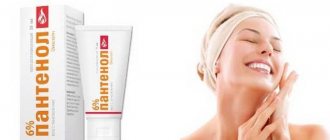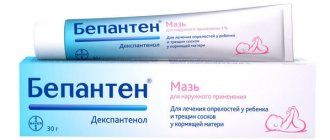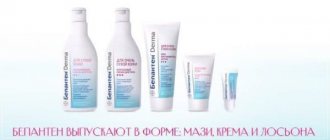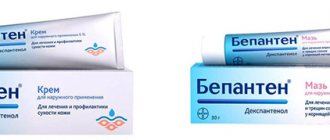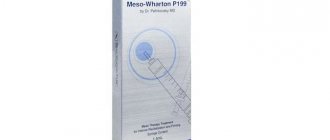For effective treatment of skin diseases, it is important not only to get rid of painful symptoms, but also to determine the cause that provoked pathogenic disorders.
But what to do in cases where we are talking about medicinal analogues that have similar therapeutic properties? What should you consider when choosing? It is not surprising that a huge number of related questions arise. A striking example of this is which is better: Bepanten or Dexpanthenol for skin cracks, abrasions, burns or wounds. Let's take a closer look at the features and differences of these medicines in more detail.
Composition and release form
An external medicine that improves tissue trophism and accelerates their regeneration is Dexpanthenol. The instructions for use indicate that ointment, cream or gel 5%, aerosol or spray are in demand in dermatology and surgery. Reviews from dermatologists report that this medication helps in the treatment of burns, bedsores, diaper rash or diaper dermatitis in adults, children (including infants and newborns). The main active ingredient of the drug is dexpanthenol. Dosage forms:
- ointment for external use 5%: a homogeneous mass of light yellow color, with a characteristic odor of lanolin (25 g or 30 g in an aluminum tube, 1 tube in a cardboard pack; 25 g in a jar, 1 jar in a cardboard pack);
- aerosol for external use 5% (58 g each in an aluminum aerosol can with a continuous valve, 1 can in a cardboard box).
1 g of ointment contains:
active ingredient: dexpanthenol - 0.05 g.
auxiliary components:
- cholesterol;
- petrolatum;
- methyl parahydroxybenzoate (nipagin);
- Vaseline oil;
- white petroleum jelly;
- isopropyl myristate;
- propyl parahydroxybenzoate (nipazole);
- purified water.
The active ingredient of the aerosol is dexpanthenol, its content in 1 container is 2.5 g.
Differences between D-Panthenol and Bepanten
These products for stimulating epidermal regeneration are produced by different pharmaceutical companies:
- Bepanthen® is produced by Bayer (Germany);
- D-Panthenol® is manufactured by Jadran Galenski Laboratorij (Croatia).
The drugs differ in the composition of the auxiliary components.
There are also differences in the packaging of creams and ointments by different manufacturers.
D-Panthenol® (cream, ointment) is packaged:
- in aluminum tubes (25, 30, 35 or 50 g);
- in dark glass jars (5, 10, 15, 20, 25, 30, 35 or 50 g).
But most often on sale there are packages in aluminum tubes of 25 and 50 g.
Bepanthen® cream and ointment is available only in aluminum tubes, packaged in 30, 50 or 100 g. The ointment can be packaged in small tubes of 3.5 g.
The main difference between Bepanten and D-Panthenol is the use of the safest additional components to obtain the same dosage forms (ointment, cream).
Cream for newborns Dexpanthenol
The drug for external use Dexpanthenol contains a derivative of pantothenic acid - a B vitamin, which on the surface and in the thickness of the skin is converted into pantothenic acid and stimulates the division of epithelial cells, the process of tissue regeneration and cellular metabolism. Dexpanthenol cream, penetrating into tissues, stimulates lipid and carbohydrate metabolism, the formation of porphyrins and corticosteroids. In medical practice, this ointment is used to treat damage and dryness of the skin of various etiologies. In what cases is it used in children:
- Diaper dermatitis.
- Minor abrasions and mild irritation after ultraviolet exposure and x-ray exposure.
- Preventing or treating diaper rash.
- It is worth knowing that it is forbidden to lubricate wet surfaces with ointment.
When used in patients with trophic ulcers on the lower extremities or long-healing skin grafts, the treatment course must be carried out under the supervision of a doctor. According to the instructions, it is allowed to use the ointment for the treatment and regeneration of a baby’s skin with diaper dermatitis, the treatment of diaper rash, minor scratches, abrasions, and burns after exposure to ultraviolet radiation in newborns. The occurrence of adverse reactions and symptoms of overdose is extremely rare. Minor allergic reactions to the active substance of the drug are possible.
Compound similarities
Both drugs contain the same active ingredient – dexpanthenol (5%).
The mechanism of action of these regenerating agents is based on the property of the active component (Dexpanthenol) to be converted into pantothenic acid, stimulating acetylation in the cellular structures of the epidermis. Pantothenic acid is a B vitamin, a coenzyme A enzyme that is easily soluble in water. As part of CoA, the active component takes an active part in carbohydrate and lipid metabolism. Under the influence of these drugs the following processes occur:
- regeneration of the epidermis;
- normalization of metabolism in skin cells;
- stimulation of fibroblast division;
- acceleration of mitosis;
- reduction of swelling and itching;
- moisturizing the stratum corneum of the epidermis.
- increasing the strength of collagen fibers.
The drugs have the same indications:
- burns;
- cuts, abrasions;
- dry skin;
- dermatitis (including diaper dermatitis);
- cracks in the nipples of the mammary glands;
- diaper rash;
- boils, trophic ulcers;
- anal fissures;
- cervical erosion;
- bedsores.
D-Panthenol has the following indications: burns, cuts, abrasions.
These products are also recommended to stimulate recovery processes after skin grafting operations.
D-Panthenol and Bepanten have 2 release forms:
- ointment;
- cream.
Due to its oily structure, the ointment is used to protect exposed skin (hands, face) from wind and cold.
The cream has a lighter consistency, so it is quickly absorbed without leaving a greasy residue. Comparative table of additional components included in the ointment:
| Excipient in the ointment | Bepanten | D-Panthenol |
| Protegin X | + | |
| Cetyl alcohol | + | |
| Stearyl alcohol | + | |
| Beeswax white | + | |
| Lanolin | + | + |
| Paraffin soft white | + | |
| Almond oil | + | |
| Liquid paraffin | + | |
| Distilled water | + | + |
| Vaseline white | + | |
| Vaseline oil | + | |
| Myristic acid isopropyl ester | + | |
| Cholesterol | + | |
| Methyl and propyl esters of p-hydroxybenzoic acid | + |
The similarity in the composition of these drugs released in the form of an ointment is limited to the following additional components:
- lanolin;
- distilled water.
Comparative table of additional components included in the cream:
| Excipients in the cream | Bepanten | D-Panthenol |
| DL-pantolactone | + | |
| Phenoxyethanol | + | |
| Potassium cetyl phosphate (amphisol K) | + | |
| Cetyl alcohol | + | + |
| Stearyl alcohol | + | |
| Lanolin | + | |
| Isopropyl myristate | + | |
| Propylene glycol | + | + |
| Purified water | + | + |
| Ketomacrogol 1000 | + | |
| Cetearyl octanoate | + | |
| Dimethicone | + | |
| Glyceryl monostearate | + | |
| Methyl and propyl esters of p-hydroxybenzoic acid | + | |
| Flavor "Seaside" | + |
These drugs, released in the form of a cream, have the following identical auxiliary components in the composition:
- propylene glycol;
- purified water;
- cetyl alcohol.
Due to its oily structure, the ointment is used to protect exposed skin (hands, face) from wind and cold.
Mechanism of action of Dexpanthenol
Dexpanthenol is an analogue of pantothenic acid, a stimulator of the synthesis of coenzyme A, which is involved in almost all metabolic processes, including the metabolism of fats and carbohydrates. Dexpanthenol stimulates the acetylation of choline and its subsequent conversion to acetylcholine, and also stimulates the synthesis of corticosteroid hormones. Due to its good ability to penetrate tissue in high local concentrations, dexpanthenol is used as the main active pharmacological ingredient in many dosage forms for external use (for example, ointments and lotions, sprays).
Promotes intensification of the formation of epithelial tissue.
The substance is used to treat dermatological conditions to relieve itching or promote the healing of entire epithelial disorders resulting from traumatic injuries, exposure to high temperatures or UV radiation. Dermatological effects of topical dexpanthenol include increased fibroblast proliferation and accelerated re-epithelialization during wound healing. In addition, it exhibits protective and moisturizing properties, and drugs based on this component can also be used to prevent damage to various parts of the body.
Dexpanthenol ointment: indications for use
The drug is used in medicine to treat various skin lesions, dermatological diseases and inflammations. Dexpanthenol gel is prescribed for the following diagnoses and conditions:
- thermal, chemical and sunburns;
- skin restoration after transplantation;
- increased dryness due to vitamin deficiency, dehydration;
- trophic ulcers on the legs;
- poorly healing wounds;
- anal fissures;
- bedsores;
- frostbite of the face.
Dexpanthenol can be used to treat wounds after surgery and remove sutures. The ointment helps relieve skin inflammation when a colostomy is installed, after a tracheotomy. It is recommended during lactation to eliminate painful cracks in the nipples. In pediatrics, Dexpanthenol is used for the following indications:
- atopic and diaper dermatitis;
- skin treatment for hypersensitivity in a premature baby;
- redness and burning after exposure to the sun or cold air.
Dexpanthenol ointment for hemorrhoids helps relieve discomfort, moisturizes and softens the skin around the anus. It is prescribed after surgery to remove hemorrhoids, for paraproctitis, for accelerated healing and restoration of wounds. For burns and irritation, Dexpanthenol ointment can be used to restore facial skin after chemical peeling, cleansing or other cosmetic procedures. It can be applied to the eyelids after plastic surgery to speed up regeneration, increase elasticity and reduce swelling.
Patient reviews
Alexandra, 36 years old, Nizhny Novgorod: “I use Bepanten cream to restore the skin after a peeling procedure. This product is also recommended for rapid healing of the skin and relieving swelling after tattooing (Bepanten Plus). The drug in ointment form can be used as a nighttime skin nourisher (especially if you add the contents of a vitamin E capsule to it).”
Marina, 23 years old, Kazan: “I’m buying D-Panthenol for my child. There are no allergic reactions. Fragrance and petroleum jelly are no more potentially dangerous than cetyl or stearyl alcohol.”
Price
| Drug name | Dosage form of release | Net weight, g | price, rub. |
| Bepanthen® | Cream | 30 | 450 |
| 50 | 560 | ||
| 100 | 770 | ||
| Ointment | 30 | 430 | |
| 50 | 540 | ||
| 100 | 760 | ||
| D-Panthenol® | Cream | 25 | 290 |
| 50 | 430 | ||
| Ointment | 25 | 275 | |
| 50 | 420 |
When comparing similar dosage forms and packaging of these drugs (cream and ointment, 50 g), it is clear that D-Panthenol (430 and 420 rubles) is cheaper than Bepanten (560 and 540 rubles).
What is the ointment for?
The drug is intended for application to the surface of skin that has been subjected to thermal or radiation burns. The following pathologies are indications for its use:
- eczema, ulcers, including trophic ones;
- cuts, cracks, wounds, scratches;
- dry skin, causing injury;
- complex treatment of bedsores;
- furunculosis.
Dexpanthenol in the form of gel and cream is used in the postoperative period to accelerate the healing of sutures. Dexpanthenol is often used to eliminate allergy symptoms in contact dermatitis or neurodermatosis. Before applying the drug, aseptic treatment of the damage is required. The wound or cut is washed to remove mechanical impurities. Then they are treated with solutions with a disinfectant effect (Chlorhexidine, Miramistin) and dried. If Dexpanthenol is intended for the treatment of children, then a 1-2 cm strip of the product is sufficient. For therapy in adults, this amount increases by 2-3 times. The drug is applied and evenly distributed on the skin 2-4 times a day. During treatment with Dexpanthenol E cream with tocopherol acetate, the same dosage regimen is followed.
What is Vertex Dexpanthenol ointment used for?
Dexpanthenol is a derivative of pantothenic acid. Pantothenic acid, a water-soluble B vitamin, is a component of coenzyme A. It stimulates skin regeneration, normalizes cellular metabolism, and increases the strength of collagen fibers. An increased need for pantothenic acid is observed when the skin or tissues are damaged, and its deficiency can be compensated for by the local use of dexpanthenol. Optimal molecular weight, hydrophilicity and low polarity make it possible to penetrate into all layers of the skin. Has a regenerating, weak anti-inflammatory effect. Indications for the drug Dexpanthenol-VERTEX:
- Violations of the integrity of the skin caused by mechanical, chemical, temperature factors or after surgical interventions (burns of various origins (including sunburn);
- scratches, abrasions, wounds;
- bedsores; poorly healing skin grafts;
- aseptic postoperative wounds);
- inflammatory processes on the skin;
- dermatitis;
- boils;
- trophic ulcers of the lower extremities;
- skin care around tracheostomy, gastrostomy and colostomy;
- treatment and prevention of the consequences of adverse effects on the skin of environmental factors (cold, wind, dampness);
- in children - diaper dermatitis, scratches and minor irritation after exposure to the sun, ultraviolet and x-rays;
- treatment and prevention of diaper rash;
- cracks and inflammation of the nipples of the breast in nursing mothers;
- for the treatment and protection of dry skin as a source of neutral fats and dexpanthenol
Panthenol or D - Panthenol - which is better?
We will also find out what is the difference between the drugs Panthenol, D-Panthenol and Bepanten. Let's get acquainted with the methods of using the product in cases of pregnancy, breastfeeding and for infants.
What is PANTHENOL?
Panthenic acid (or vitamin B5) is formed due to the action of biochemical oxidation processes in the hairy parts of the body and on the skin.
Panthenol is a provitamin B5, and it is divided into two types, namely D-Panthenol and L-Panthenol.
Only D-Panthenol is used for medicinal and cosmetic purposes due to its unique biological activity.
D-Panthenol promotes the beginning of the natural process of tissue repair and trophism; the drug is a pharmaceutical agent.
Its main active ingredient is dexpanthenol, which has a positive effect on the epithelial cells of the epidermis, thereby restoring their structure. In addition, it has anti-edematous and antipruritic effects.
The drug D-Panthenol has the following positive properties:
• has a pronounced anti-inflammatory effect; • relieves irritation from the surface of the epidermis; • heals wounds; • relieves skin from peeling, restoring it and moisturizing it; • after sunburn, regenerates the skin; • used for chafing and redness.
Cosmetologists use D-Panthenol as a cream after depilation procedures in the bikini area and armpits.
D-Panthenol is presented in the form:
• 5% cream for external use, 25 and 50 g. • 5% ointment for external use, dosage 25, 35, 50 and 100 g.
Panthenol is presented in the form:
• Aerosols Panthenol; • 5% ointment for external use; • Cream foams for external use; • Body milk; • Sprays with different levels of protection from UV rays for safe tanning; • Balm for restoring skin after sunburn.
We also list ointments for children's skin based on Panthenol:
• Spray for protection against ultraviolet radiation; • 3% children's universal cream Panthenol; • Baby body milk after sunbathing Panthenol + Sea buckthorn.
Panthenol restores damaged skin.
Cream D-Panthenol:
If we talk specifically about D-Panthenol cream, it helps to increase the skin's resistance to various negative factors, and also accelerates the process of synthesis of elastin and collagen.
The product promotes the healing of thermal burns by actively stimulating skin regeneration.
D-Panthenol ointment - at the site of damage to the skin, replenishes the lack of pantothenic acid. It is also involved in the synthesis of the breakdown of steroid hormones and fatty acids.
The hydrophilicity of D-Panthenol allows the ointment to penetrate the lower layers of the epidermis, softening it and improving tissue trophism. It is quickly absorbed from the surface of the skin, and then binds to blood beta globulins and albumins.
Indications for use and contraindications:
Due to its properties, D-Panthenol cream is actively used in various fields of medicine: cosmetology, surgery and pediatrics.
• in case of violations of the integrity of the skin: cracks, burns, scratches. • for bedsores and extensive skin damage; • for trophic ulcers; • for cracks and inflammation of the nipples in nursing mothers; • for sunburn; • for postoperative aseptic wounds; • for anal intercourse; • with non-healing skin grafts; • for the prevention and treatment of diaper rash in children; • for cosmetic defects: for the treatment of acne, boils, acne; • for diaper dermatitis in babies.
For prevention purposes, Panthenol is used to moisturize the skin and eliminate dryness.
The drug is absorbed from the surface of the skin instantly, leaving no greasy marks on the skin, and the therapeutic effect will be noticeable immediately.
There are also restrictions on the use of the drug in cases where there is hypersensitivity to one of the constituent components. Or in cases of severe renal failure and in the presence of weeping wounds.
Use during pregnancy:
Both Panthenol and D-Panthenol are also used by pregnant women, since the components included in the products do not penetrate the placental barrier and are not able to have any effect on the developing fetus.
Women confirmed the effectiveness of D-Panthenol ointment and cream, which they used during pregnancy and while caring for a newborn baby.
How to use?
Use of the ointment is recommended up to 4 times a day. The product is applied in a thin layer to intact skin areas and gently rubbed in.
Please note:
Before applying the ointment to wounds and abrasions, the skin area must be treated with any antiseptic solution, it can be chlorhexidine or miramistin, but not hydrogen peroxide. There is no need to wash off the ointment with water.
• In cases of diaper rash and diaper dermatitis in children, the ointment is applied after hygiene procedures using water and soap. In this case, the use of wet wipes is unacceptable. D-Panthenol is applied to reddened and inflamed areas of the child’s body 4-5 times a day.
• When breastfeeding, cracked and bleeding nipples should also be treated with D-Panthenol. The ointment should be rubbed in a circular motion until completely absorbed after each feeding and pumping of the breast.
• If you receive burns, the use of ointment is possible from the very first minutes. The product is applied to the burn surface in a thin layer, with smooth rubbing movements, while the fingers should “barely touch” the skin.
What is the difference between Panthenol and D-Panthenol?
There is no significant difference between these drugs. They are identical in their composition and spectrum of action, so they are interchangeable. The difference between the drugs lies only in the manufacturer of the drug substance, which sets its own price for the drug.
What analogues of D-Panthenol exist?
D-Panthenol ointment can be replaced with the following means:
Dexpanthenol ointment is a medicine made from pantothenic acid. The drug has regenerating and anti-inflammatory properties;
Pantoderm ointment is an analogue of Panthenol, also used for scratches, burns, cuts and wounds;
Bepanten cream significantly accelerates the launch of regeneration processes in damaged skin areas.
Bepanten is recommended for use in caring for the delicate skin of infants - it eliminates diaper rash and relieves redness.
The product is used to treat deep abrasions and microtraumas.
Things to note:
D-Panthenol is actively used by expectant mothers during pregnancy and lactation. Panthenol is considered a representative of the class of vitamins; the product is not hormonal. It can also be used in caring for a baby from the first day of his life.
It should be noted that D-Panthenol does not protect the skin from exposure to sunlight, but it does a good job of restoring the epidermis after UV radiation burns. There were no allergic reactions to the use of the product.
In the “Solnechnoe Zdorovye” pharmacy chain you can always buy the drugs mentioned in the article at the best price in the city.
A wide range of medicines and beauty products are always close to you.
What is ointment used for in children?
Dexpanthenol is one of the medications used for various skin lesions. This medicine is in demand among young mothers because it helps with cracked nipples. Is it possible to use it in infants and how does this drug act on children's skin? Dexpanthenol has the ability to stimulate regenerative processes in tissues. After application to the skin, the active substance of the drug is converted into pantothenic acid, which is actively involved in many metabolic processes. It stimulates the regeneration of skin cells and normalizes their metabolism, and also increases the strength of collagen fibers.
The use of Dexpanthenol for children is possible from birth. This drug is harmless for both newborn babies and infants up to one year old.
The drug should not be used in children with hypersensitivity to any of the components of the ointment. In addition, treatment with Dexpanthenol is prohibited for weeping wounds. The medication is used only for external treatment. The ointment should be applied to damaged areas once a day or more often if indicated for this. For an infant, the medicine is applied to the skin after bathing or changing a diaper. Nursing mothers are advised to lubricate their nipples after feeding, and the drug should be washed off before the next feeding. Most reviews from parents who used Dexpanthenol for various skin problems in children note a good healing effect of the drug. Mothers are satisfied with the ease of use of the medication and safety for children of any age. The ointment is also praised for its low price.
Reviews from doctors
Stikhanov V. A., dermatologist: “Good dermatoprotectors based on dexpanthenol. Nourish, heal and moisturize the epidermis. Suitable for people with sensitive and dry skin. German Bepanten has many forms of release: antiseptic cream supplemented with chlorhexidine dihydrochloride (Bepanten Plus), care products for newborns (Bepanten Baby series), as well as cosmetic preparations (lotions, gels, etc.). Croatian D-Panthenol contains petroleum jelly and fragrance, so it may cause adverse reactions if you are intolerant to these substances.”
Ogneva I.M., pediatrician: “I recommend using only Bepanten ointment for newborns, because this product is as safe as possible. Allergic reactions in newborns are unpredictable, so for children in the first months of life it is recommended to use products that do not contain petroleum jelly, parabens and fragrances. Bepanten can be applied not only after bathing, but also after each diaper change. The ointment heals diaper rash well, softens the skin when it dries out, and eliminates irritation and redness.”
Instructions for use
Orally 200 - 400 mg per day. Children - from 100 mg to 300 mg per day. Solution for external use: for rinsing the mouth should be diluted in half in an equal ratio with water, for the scalp 1 to 3, for inhalation the solution should not be diluted. Dexpanthenol 5% in external form (cream or ointment) is applied topically once a day, not washed off. The gel is also used, but with a frequency of 2-3 times a day. The aerosol is used intranasally. Children from 6 years old and adults 1-2 injections into each nostril 2-3 times a day. For newborns with diaper rash, it is necessary to first wash the affected area, wipe the skin dry, and only then apply the product. Infants usually tolerate the medication well.
During pregnancy and breastfeeding. During pregnancy, dexpanthenol is approved for use in external form. During lactation, if there are cracks in the nipples, a few drops of ointment or cream should be applied after feeding the newborn. The medication must be washed off before feeding.
How to take D-Panthenol and Bepanten
Cream or ointment is applied 1-4 times a day to the area of damaged epidermis cleaned with antiseptic agents. Regenerating drugs should not be used to treat weeping wounds. When using these medications, avoid contact with the eyes.
When applied externally, dexpanthenol is quickly absorbed by the skin, because molecular weight, hydrophilicity and low polarity allow it to penetrate into all layers of the epidermis. Pantothenic acid binds to plasma proteins (beta-globulin and albumin), is not metabolized and is excreted unchanged from the body.
When treating cracked nipples, you can apply compresses using these drugs after each feeding.
To prevent diaper dermatitis, Bepanten or D-Panthenol is applied under the diaper after each bath.
To heal anal fissures and cervical erosion, the drug is applied 1-2 times a day. The duration of the course of treatment is adjusted by the doctor.
Contraindications and side effects
Qualified doctors do not prescribe this drug to people who are allergic to the composition of Dexpanthenol. The drug has no other restrictions. Use of the drug during pregnancy For pregnant women, as well as mothers during lactation, doctors prescribe the use of Dexpanthenol without any restrictions. This remedy helps heal cracks in the nipples, as well as relieve inflammation. It is important to remember to cleanse the skin of the gel immediately before feeding your baby. The use of Dexpanthenol should be stopped if a woman develops a rash and allergies. In this case, you also need to consult a doctor.
There is a small risk of an allergic reaction and rash in a patient who has used a large amount of the product.
Dexpanthenol combines well with succinylcholine, increasing its effect. No other interactions were identified. Some patients prefer to use different gels, applying them to the same area of the skin. In this case, experts advise alternating their use, applying the next drug after a while. To date, no cases of overdose with Dexpanthenol have been identified. There are no complications even when taking the gel orally.
According to experts, patients using Dexpanthenol rarely experience any side effects. This drug is well accepted even by children's bodies. In some cases, an allergy appears caused by the body's increased sensitivity to the components that make up Dexpanthenol. In such a situation, you should immediately interrupt treatment and contact your doctor.
Side effects of D-Panthenol and Bepanten
These drugs have low adsorption, so prolonged or heavy application to the skin does not have a systemic effect. The preparations contain only non-toxic substances.
In exceptional cases, a hypersensitivity reaction may occur. For example, allergies may manifest in the form of dermatitis, erythema, hyperemia, itching, and exanthema. Local skin reactions (for example, contact dermatitis) can be caused by some of the excipients included in these drugs (cetyl alcohol, stearyl alcohol, lanolin). Propylene glycol can also cause skin irritation.
What can I replace the cream with?
If necessary, a replacement can be found for the drug. There are quite a lot of drugs that are similar in composition and action. Here are some of the drug's analogues:
- Panthenol;
- D - Panthenol;
- Bepanten;
- Bepanten plus;
- Pantoderm;
- Panthenol Pharmstandard;
- Pantoderm;
- Krneregel.
There are still many substitutes. Each of them has its own specific characteristics. Before use, be sure to read the instructions. Despite the abundance of analogues, Dexpanthenol is often compared with Panthenol. Sometimes doctors themselves recommend one of these remedies to choose from. Indeed, the composition and effect of these medications are very similar. The main component for both products is dexpanthenol. Bepanten is a more expensive product in terms of cost. In addition to medicinal components, it also includes caregivers. They soften and moisturize the skin.
Based on reviews and practice, the drug is really high quality and effective. Produced by some German pharmaceutical companies. Dexpanthenol is produced by domestic manufacturers. Much more affordable. And, according to reviews, its effect is no worse.
Panthenol and Dexpanthenol: what is the difference?
Both products contain dexpanthenol. The products have no side effects and are actively prescribed in pediatrics for the treatment of abrasions, wounds or other injuries to the skin, for the treatment of dryness and diaper rash. Used as a prophylactic agent in cosmetology. An additional function is the restoration of metabolism at the cell type level, as well as the restoration of collagen fibers. Dexpanthenol contains pantothenic acid, which penetrates deeply into all layers and begins to act almost instantly. Stimulation of regeneration and cellular metabolism occurs. Has a healing and anti-inflammatory effect.
As auxiliaries: petroleum jelly and petroleum jelly, isopropyl myristate, which ensures rapid deep penetration and absorption. It acts locally, the active components do not enter the bloodstream, but act exclusively at the level of cells that are damaged, which minimizes the possibility of intoxication. D Panthenol contains dexapanthenol (pantothenic acid). Excipients: beeswax, lanolin, propylene glycol, paraffin. Thanks to these substances, rapid absorption occurs, which makes the product very convenient to use.
Which is better: Bepanten or Dexpanthenol?
If we are guided solely by patient reviews, then the drugs Dexpanthenol and Bepanten are complete analogues with comparable effectiveness. A superficial comparison only confirms this opinion. We are talking about almost identical pharmaceutical products, the main difference between which is the manufacturer. After treating the problem area of the skin, the active agent (provitamin B5) is converted into pantothenic acid. This substance is close in composition to the components of the dermis, and therefore is best suited for its regeneration, moisturizing and treatment. Properties of dexpanthenol:
- moisturizes and saturates the dermis with nutrients;
- stimulates cellular regeneration in damaged segments;
- eliminates swelling, inflammation, redness and irritation;
- promotes rapid healing of cracks, abrasions and shallow wounds.
Both drugs are indicated for burns of the skin, diaper rash, dermatitis, bites, erosions, bedsores and trophic ulcers. There is no fundamental difference in terms of pharmacological action and effectiveness between the two drugs. But differences still exist. Cream Panthenol, D-Panthenol, Dexpanthenol and Bepanten are representatives of the clinical and pharmacological group of tissue regeneration stimulators. These are drugs that normalize tissue trophism and intracellular metabolic processes. High therapeutic effectiveness is achieved due to rapid epithelial absorption and penetration into the deep spheres of the skin.
Bepanthen and Dexpanthenol, what is the difference?
These are drugs whose main active ingredient is dexpanthenol. Provitamin B5 contained in the products is converted into pantothenic acid. Bepanten together with Dexpanthenol:
- promote healing of wounds, cracks and abrasions;
- relieve irritation, swelling and redness;
- accelerate cell regeneration; moisturize and nourish the skin.
The anti-inflammatory activity of the drugs allows them to be used for diaper rash, dermatitis, insect bites and anal fissures. Medicines are prescribed: for the treatment of trophic ulcers; erosions; bedsores. Bepanten and Dexpanthenol are prescribed for the treatment of bedsores. The main difference between the 2 drugs is the excipients they contain. The composition of Dexpanthenol ointment includes
:
- nipazole;
- petrolatum;
- cholesterol;
- Vaseline oil;
- purified water;
- isopropyl myristate;
- nipagin.
Bepanten contains beeswax. Bepanten includes:
- paraffin;
- beeswax;
- protein;
- cetyl and stearyl alcohol;
- lanolin, made from sheep fat;
- almond oil;
- water.
The first remedy is based on inexpensive chemicals and preservatives, which did not in any way affect its therapeutic properties, but did affect its price. Bepanten is a more expensive analogue. Due to its natural composition, it is not dangerous for the skin, because... does not clog pores and does not cause allergies. There is no significant difference which drug an adult should use for treatment. Therefore, Dexpanthenol is most often purchased due to its inexpensive price and effective effect.
Description of drugs
Many patients ask a logical question - what is the difference between Dexpanthenol and more famous analogues? From the point of view of pharmacological action, preparations based on provitamin B5 are substitutes. Their main purpose is to stimulate tissue regeneration and intracellular metabolism. Medicines are prescribed when the integrity of the skin is damaged, regardless of the etiology (dry skin, diaper rash, cracks, burns, etc.).
Depending on the location of the disease process, one or another form of medication is prescribed. Most often we are talking about ointments, creams, sprays, gels and lotions. Before using the drug, it is important to consult with a dermatologist, who will not only prescribe the appropriate medication, but also develop an individual therapeutic regimen.
Pharmacological action and group
Cream Panthenol, D-Panthenol, Dexpanthenol and Bepanten are representatives of the clinical and pharmacological group of tissue regeneration stimulators. These are drugs that normalize tissue trophism and intracellular metabolic processes. High therapeutic effectiveness is achieved due to rapid epithelial absorption and penetration into the deep spheres of the skin.
Features of pharmacological action:
- After application to the surface of the skin, liniment is quickly absorbed by the epithelial layer, forming pantothenic acid (through interaction with plasma protein compounds).
- The active component is a catalyst for acylation processes.
- Water-soluble provitamin B restores cellular metabolic reactions and stimulates tissue regeneration.
- Pantothenic acid increases the elasticity and strength of collagen fibers.
The nominal polarity and high hydrophilicity of the active ingredients determine their ability to penetrate into the deep layers of the skin.
Release form and composition
Bepanthen and Dexpanthenol also differ in their release form. The first drug is available in 3 versions - ointment, cream and lotion (aerosol). As for Dexpanthenol, it is produced not only in the form of an ointment, but also as an eye gel used in ophthalmology. Bepanten is packaged in 3 and 30 g aluminum tubes, as well as 200 ml plastic bottles. The domestic analogue is available in 30 g metal tubes, as well as in the form of an injection solution.
What unites the medications under consideration is the concentration of the main active ingredient, provitamin B5, 5%.
Composition of Dexpanthenol:
- distilled water;
- propyl parahydroxybenzoate;
- Vaseline oil extract;
- methyl parahydroxybenzoate;
- isopropyl myristate.
Their main purpose is to enhance the action of the main component. Among the minor ingredients of the domestic manufacturer, synthetic substances predominate.
The pharmaceutical product of the German company Bayer is distinguished by exclusively natural ingredients: organic lanolin, beeswax, paraffin, alcohols, almond oil extract.
Aquamaris plus with dexpanthenol
Aquamaris plus spray is a product of natural origin. It is produced in glass bottles containing a colorless, transparent, odorless solution. Its components are:
- Sea water with mineral elements in the form of magnesium, calcium, sodium, chlorine.
- Dexpanthenol, which is a derivative of vitamin B5. It restores and simulates the effects of microelements in sea water.
This composition effectively moisturizes the mucous membrane, prevents the penetration of viruses, and improves immunity. De-panthenol improves cell metabolism, has a slight anti-inflammatory effect and helps restore the nasal mucosa. Aquamaris plus is indicated for use in caring for the nasal cavity
:
- to cleanse the mucous membranes of smoke, pollen, various viruses and bacteria;
- after surgical interventions;
- with long-term treatment with corticosteroids;
- before using medications.
According to the instructions for use and numerous reviews, the drug is effective as a prophylactic for influenza and ARVI. According to reviews from doctors and patients, when treated with Aquamaris Plus spray, improvement occurs within two weeks. The course of therapy is usually prescribed for no more than four weeks. After a month it can be repeated. The drug is contraindicated only if the body is hypersensitive to its components. Allergic reactions may occur as side effects.
